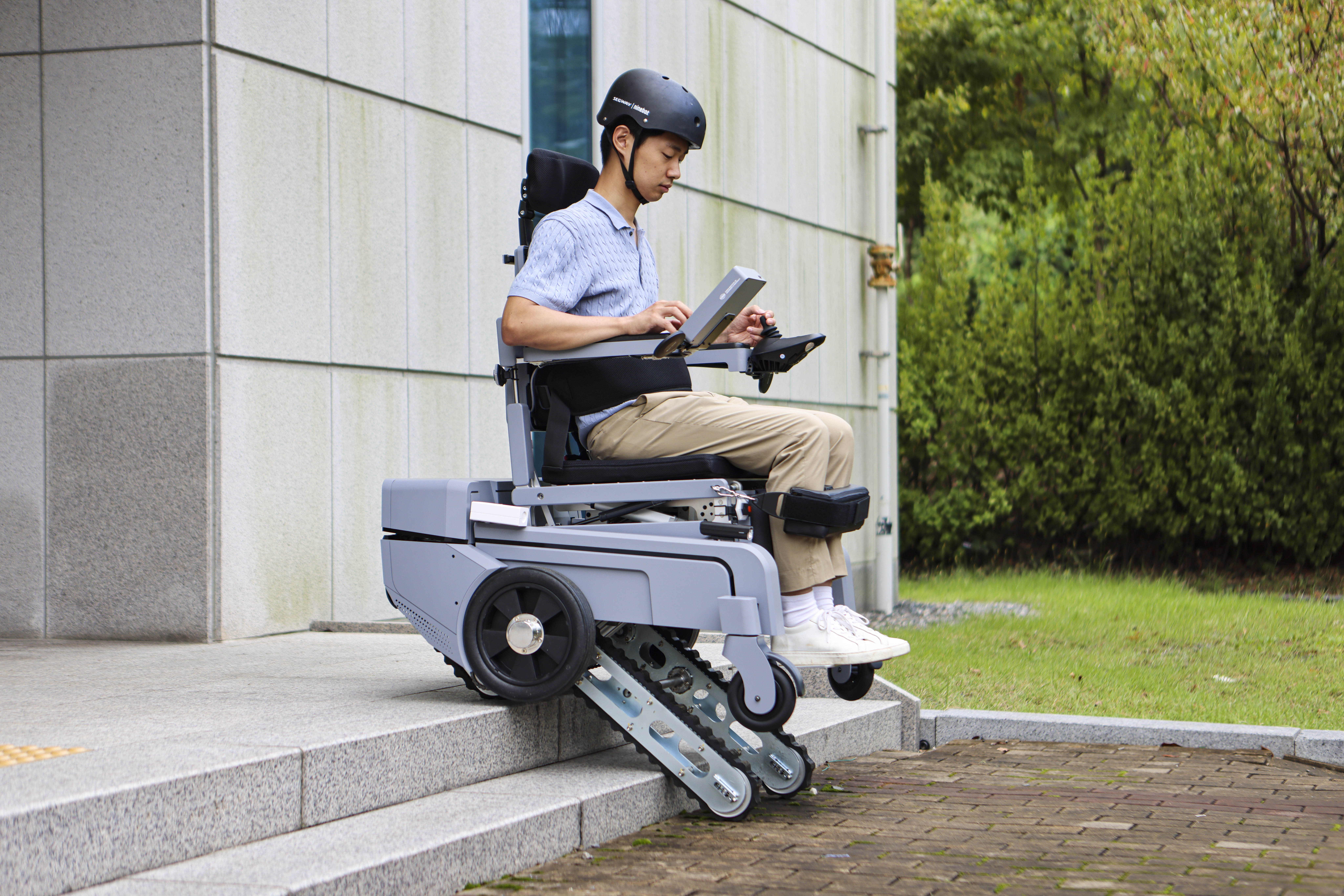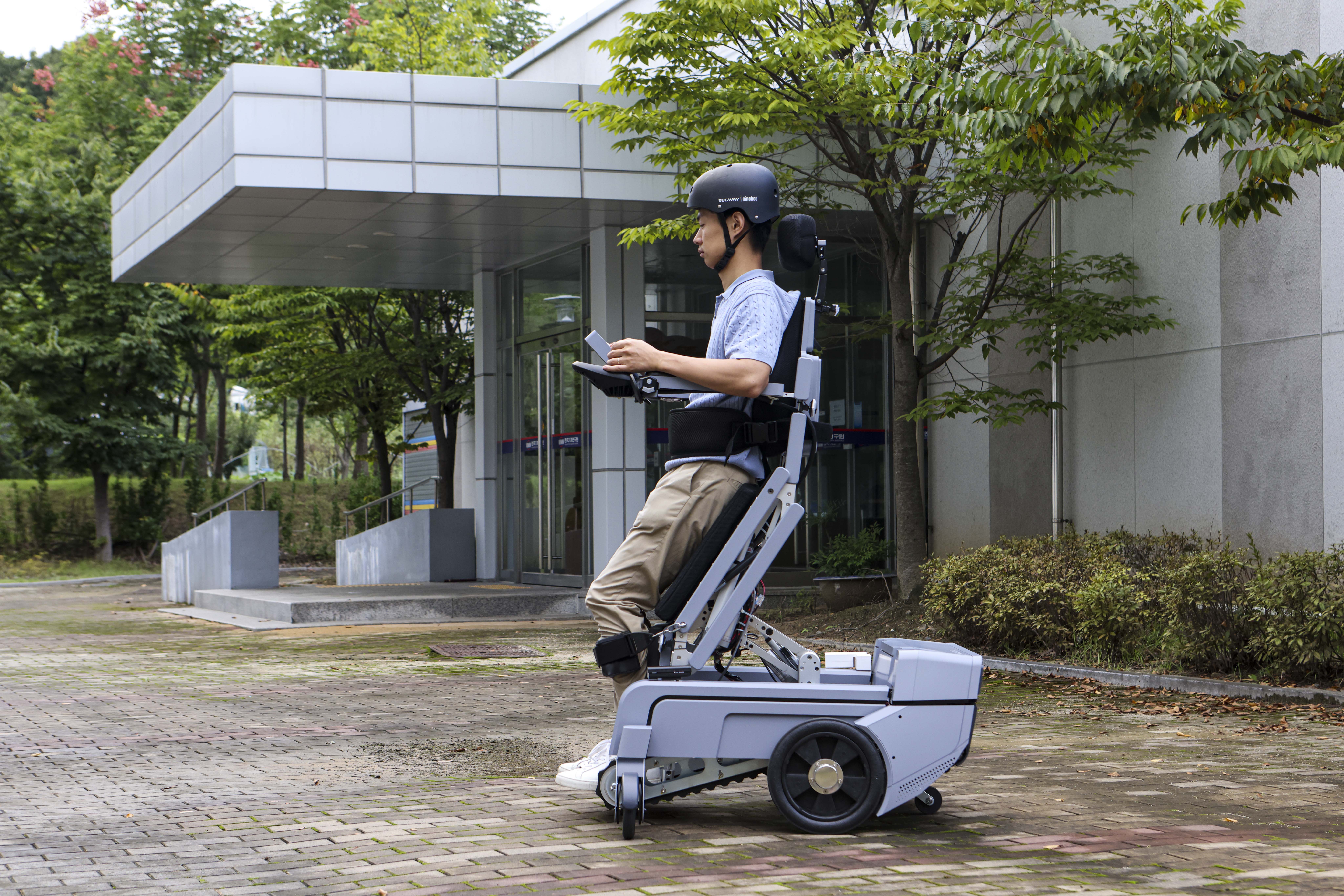
- Created2023.10.05
New robot technology helps persons with lower-limb disabilities recover their daily lives
- For the first time in the world, KIMM develops the technology for robot wheelchairs that help persons with lower-limb disabilities go up and down the stairs and move while staying standing -
- New technology is expected to improve the quality of lives of persons with lower-limb disabilities -
□ A new technology for robot wheelchairs, which helps persons with lower-limb disabilities go up and down the stairs and move while staying standing, has been developed for the first time in the world.
□ The Korea Institute of Machinery and Materials (President Sang-jin Park, hereinafter referred to as KIMM), an institute under the jurisdiction of the Ministry of Science and ICT, has embodied the “stair climbing module” for helping persons with lower-limb disabilities to climb and descend the stairs in their daily lives as well as the “standing module” for them to take various postures such as lying on the back or leaning forward while on the wheelchair, and succeeded in developing a robot wheelchair that combines these two modules.
□ The research team led by Chan-hoon Park, Director of the KIMM’s AI Robot Research Division, designed the “ㄹ”-shaped crawler* and attached it to the lower part of the wheelchair to develop the “stair climbing module,” a device for ascending and descending the stairs. This crawler is hidden inside the wheelchair in normal times and descends whenever necessary.
* Crawler: A crawler refers to the endless track used in tanks, tractors, and wheelchairs, etc., and corresponds to the wheels in a wheelchair.
□ Additionally, the research team also applied a unique parallelogram-shaped structure and a self-weight compensation technology* to develop the “standing module,” a device that allows the user to take five different types of postures including the postures of standing up while on the wheelchair, lying on the back, leaning backward and forward while seated, and adjusting the height of the seat. By doing so, the team embodied a small-sized and light-weighted module that can be operated with a motor power lower by up to 80 percent.
* Self-weight compensation technology: Self-weight compensation technology refers to the technology for minimizing the necessary torque that is generated by the weight of the robot itself.
□ Although the stair-climbing module and the standing module can be used independently, they can each be attached to the upper part and the lower part of the wheelchair and be integrated into a single robot wheelchair. This single robot wheelchair is capable of embodying the functions for climbing the stairs, moving while standing, and changing into a variety of postures. Hence, it is expected to be significantly helpful for freeing persons with lower-limb disabilities from space constraints in their daily lives.


□ In the case of conventional crawler-based wheelchairs, it was difficult to overcome the problem associated with the sliding of the wheelchair on staircases. Moreover, as there were limitations in changing postures while seated on the wheelchair, the pressure from the user’s weight was concentrated and there also was the risk of causing bedsores.
□ With the newly developed robot wheelchair, the crawler supports the edge of the stairs and the treadboard at the same time while ascending and descending the stairs, thereby resolving the problem associated with sliding, thereby also greatly improving the safety of climbing staircases. In addition, because of its specially designed shape, the robot wheelchair is capable of ascending the stairs with the simple movement of the crawler without having to go through the complicated process of controlling the wheelchair by calculating the point in time when the wheelchair initially goes up the stairs and the point in time when it passes the stairs.
□ Moreover, it is possible for the user to change into various postures while seated on the robot wheelchair, which can help to resolve the concentration of pressure, prevent bedsores, and improve the user’s blood circulation. Another advantage of the robot wheelchair is that, as the standing module for changing the posture is independent from the wheelchair, it can be attached easily without making major changes to the design.
□ Meanwhile, the research team has gone beyond the technology for ascending stairs using crawlers, and has developed the source technology for the specially designed “transforming wheels” capable of ascending the stairs just by using circular wheels. A special chain block is formed on the surface of the wheels, and the distance of the block changes depending on the direction of the transformation. To make this possible, the research team developed and applied, for the first time in the world, a new rigidity control mechanism that has imitated the surface tension of a waterdrop.
□ On a flat surface, the newly developed transforming wheels retain their form like ordinary wheels. However, when the wheels encounter an obstacle, the rigidity of the wheels decreases and the shape thereof changes in line with the shape of the obstacle, allowing the wheelchair to tread on the obstacle and pass by. This new technology will be applied to the development of more advanced robot wheelchairs in the future. As these wheels are capable of quickly moving on a flat surface and overcoming obstacles, it is anticipated that this technology will be widely used not only for robot wheelchairs but also for various mobility robots.
□ Chan-hoon Park, director of the KIMM’s AI Robot Research Division, was quoted as saying, “While the conventional technology for wheelchairs was focused on simply providing mobility, our newest technology for the robot wheelchair has been developed for the purpose of helping persons with lower-limb disabilities use facilities and infrastructure that have been designed and installed without considering people who have disabilities.” Park added, “We will try to promptly disseminate the technologies that will be developed in the future to contribute to the improvement of the lives of persons with disabilities, and we will also make our utmost efforts to develop warm-hearted robot technologies for the wellness of the mankind.”
□ Meanwhile, this research was conducted with the support of the project related to the “robot for supporting the independent lives of persons with lower-limb disabilities,” one of the KIMM’s basic projects.


